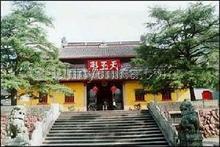Attration Category
 Tiantong Temple lies in the Taibai Mountains, 25 kilometers east of the city proper of Ningbo. The temple was built in 300 AD in the West Jin Dynasty. With its history of 1700 years, the temple is 90 years older than the Lingyin Temple in Hangzhou. As one of the ten sacred temples of the Buddhist Chan sect, Tiantong Temple is also known as "Buddha's Holy Land in Southeast China".
Tiantong Temple lies in the Taibai Mountains, 25 kilometers east of the city proper of Ningbo. The temple was built in 300 AD in the West Jin Dynasty. With its history of 1700 years, the temple is 90 years older than the Lingyin Temple in Hangzhou. As one of the ten sacred temples of the Buddhist Chan sect, Tiantong Temple is also known as "Buddha's Holy Land in Southeast China".
The ancient Tiantong Temple enjoys a loud prestige not only for its Buddhist significance, but also for its picturesque surroundings, cuddling against the soaring Taibai Mountain, in the neighborhood of luxuriant pines and bamboos, a beauty that could only be found here. For centuries the "Three Passes" and "Ten Highlights" of the temple are tantalizing romantic and poetic minds. It is due to the charming environment of mountains and water in the area that Yixing, a monk living 1700 years ago, decided to build a temple here. Legend says the Heavenly King sent God Taibai to the mortal world incarnated as a child, who assisted Venerable Master Yixing in building the temple. Thus the mountain is named Taibai and the temple Tiantong, which means "heavenly child".
Tiantong Temple is located on the ascending slope at the foot of the mountain. The whole place consists of structures like the Hall of the Four Guardian Gods, the Grand Hall, the Hall of Buddhist Rites, the Hall of Early Enlightenment, the Hall of Arhats, the Bell Tower, and the Imperial Library Tower. A stringy roofed veranda connects all these components and therefore shelters the visitors from the scorching sun and annoying rains. The veranda also helps visitors find access to any of the temple's components, an ingenuity of the architects indeed. Tiantong Temple was in its prime time during the Song Dynasty, having 999 halls, pavilions and towers altogether, a rarity across the empire in terms of its size. Unfortunately this nonpareil temple was not spared from cataclysms in the mortal world. On July 21, 1587 AD in the Ming Dynasty, a serious flood in Yinxian County wrecked all the halls of the temple. Nothing survived the flood. In the winter in the same year after the flood, Abbot Yinhuai had the halls rebuilt over the rubbles. In the following centuries, the temple came through a succession of warfare. Today, the temple has 730 houses of the architectural style formed during the Ming Dynasty, covering 58 thousand square meters.
